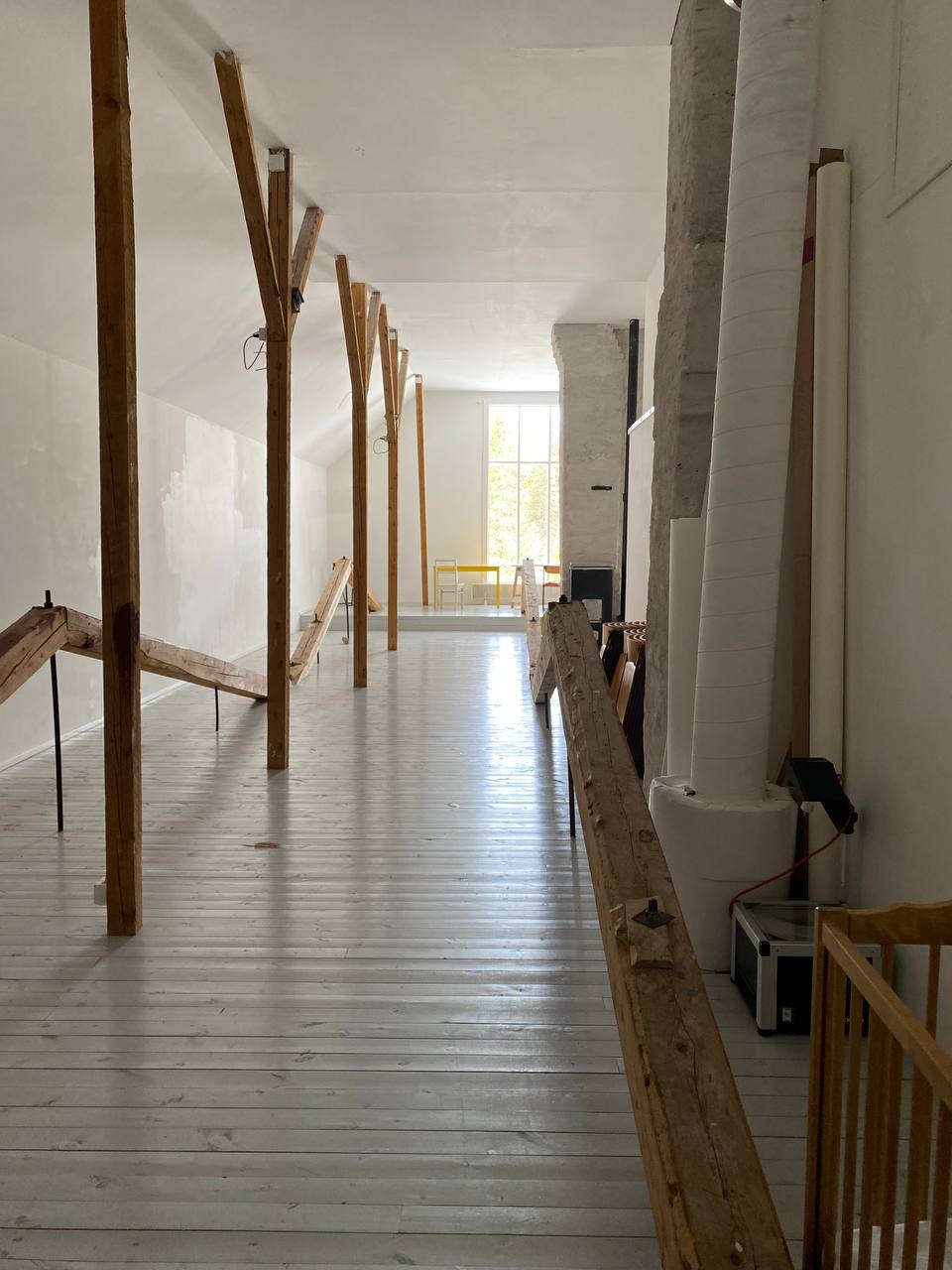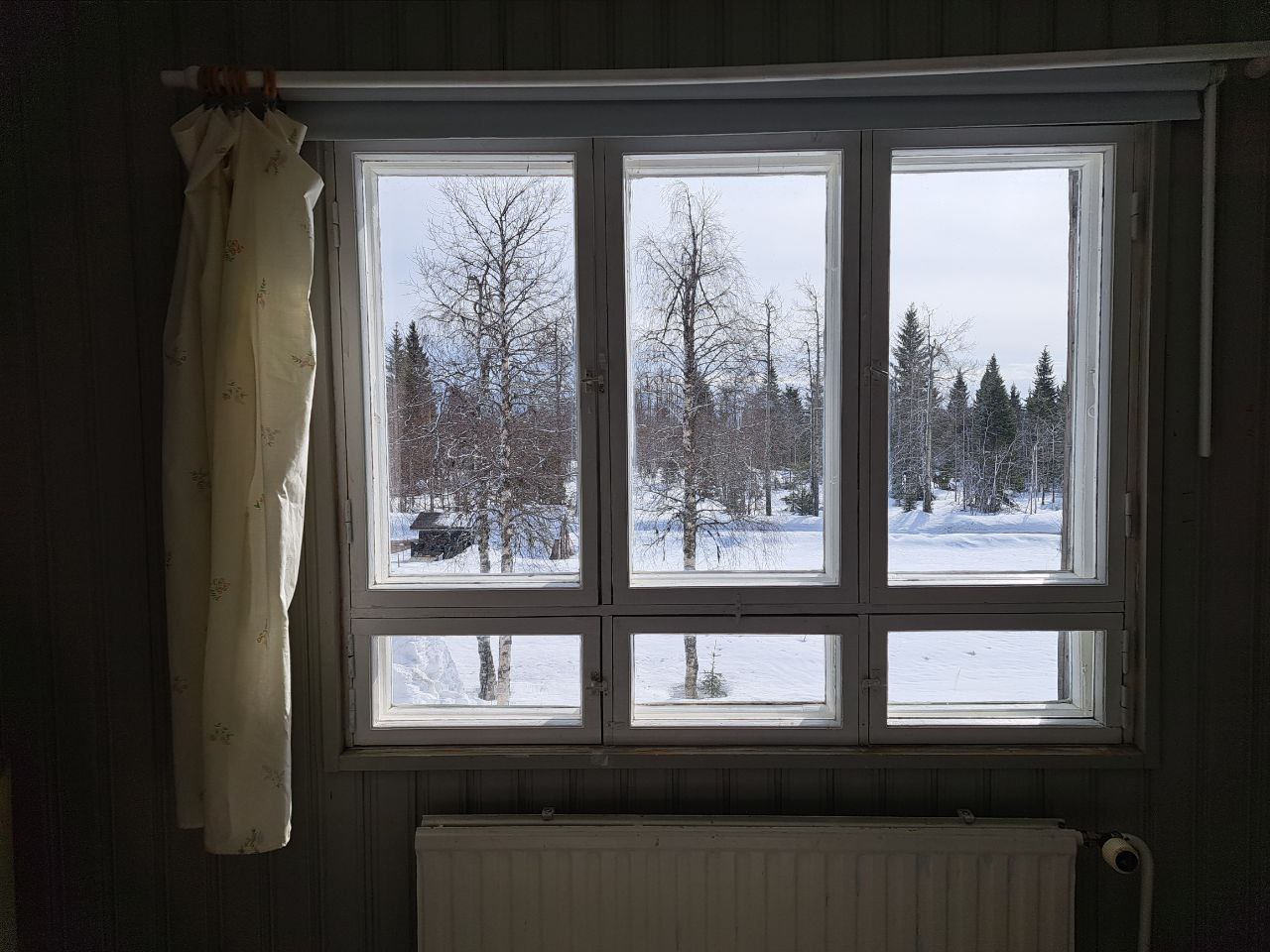Text: Angelina Davydova
Photo: Adel Kim

Text: Angelina Davydova
Photo: Adel Kim
The name Mustarinta
derives from the old Finno-Ugric language family word mustarinta
meaning “bear” and “hill of spirits”.
It was most likely people who lived in the area of Kainuu
who used this word,
and old maps refer to the area as Mustarinda
with the letter D.
A trip to Mustarinda from Helsinki takes almost the whole day. First, a train, then a bus, then Hanna Kaisa from the residency picks us up with a car, at a parking lot next to the S-Market.
Still, it is on a bus that we meet Ava Imogen Grayson, a Canadian-born sound artist, also based in Helsinki, who is now going to Mustarinda for a month. Ava is accompanied by their little dog, a former street dog from Lithuania, now a very warm and human-friendly creature often standing on its hind legs when asking for something, but at times getting a bit angry and showing its lower teeth when getting too much attention.
We are going up and down hills, Hanna Kaisa tells us that the region is called Kainuu. A hilly land with hills that still have trees growing on them – those are completely gone in Lapland, which is way up North from here. There, the hills are bare. The Finnish language has many words for a hill, so we are struggling to find enough equivalents in Russian. There are spruce and birch trees along the road, some of them hiding behind the snow banks.
Hanna Kaisa points to a waterfall, a ski and spa resort with nine saunas and a windmill park that is currently being installed. Many locals wonder why this semi-windy area has been chosen – one of the main reasons is the fact that this region is very sparsely populated (even according to Finnish standards). And there is environmental criticism about chopping down trees and intruding into the pristine nature by building roads and bringing machinery, but the need for the production of local energy, particularly in the light of diminishing fossil fuel dependency on Russia following the full-scale war in Ukraine, is more urgent.
It is cold, and there is snow, but it is also very light. It stays light until around 10 pm and it gets very light around 6 am, so that we can hardly keep on sleeping. The sun is looking at us through its giant white eye, nothing but one eye, even through the white clouds. All the birds and other animals wake up for the day. And Ava's little dog wants to go out for a walk.
Later in May, many birds will return from the South, and it will become really noisy here, says Hanna Kaisa. So far it is all so quiet.
The residency itself is a two-storied wooden building, built in the 50s. There are two other houses further out on the premises, one a summer house with an extra bedroom and a gallery space and, quite obviously, a sauna. In fact, the sauna house was built first. This is the way you build here.
The main Mustarinda house is a white labyrinth of bedrooms, some of them with flowery wallpaper, plain studios with a table, a chair, and a lot of breathing space, exhibition spaces of diverse forms and sizes, hosting plants in cardboard pots, and other rooms for housekeeping purposes scattered around various parts of the building. The house has two entrances, one staircase inside and one outside, a spacious gallery under the roof with massive wooden beams, a cozy kitchen with a stone-carved stove and a window overlooking self-made bird feeders where yellow-bellied tit birds enjoy their breakfast earlier than we do.



Hanna Kaisa warms Karelian pies for us, piirakka, sounding so familiar to пироги in Russian. My grandmother, who grew up in a half-Karelian village south-east of Leningrad, used to make them at home, calling them калитки (the name in Russian comes from a word meaning a purse or a traveling bag) from a mixture of rye and white flour, filled with rice, barley, or mashed potatoes, sometimes with a cooked egg in it. We enjoy them, along with some lightly salted salmon, baby carrots, fresh radishes, tomatoes – dipping all the vegetables into a mixture of olive oil with the local salt and foreign black pepper. Also on the table is my favorite Lappish bread cheese, leipäjuusto, that makes a crazy turn upside down and becomes juustoleipä (cheese bread).
Since there is so much snow, we cannot see where the residency garden sits.There, they grow potatoes, zucchinis, and various kinds of greens, Hanna Kaisa tells us. The earth is enriched with humus produced from biowaste collected at the house. There is also a dry toilet, the contents of which are used as a natural fertilizer.

There is a village, even though it might not be obvious, Hanna Kaisa tells us. The residency is working with the local people by inviting them to public events and organizing art classes for children. The area is becoming further depopulated, but the regular residents of Mustarinda bring their worlds, their stories, and their art from so many countries and places to this very particular house and which now feels much closer than it looks on a map. And all of them take something back, even after a short visit, like ours.
Late at night, before going to sleep, we gather in a communal living-room where wooden furniture from the 60s and 70s is reflected in the light of a disco ball hanging from the ceiling. Yoga mats, books, old and new, in many languages, a piano, and a large wooden bird also hang from the ceiling – Hanna Kaisa made it a few years ago – all make this room very homey.
In the morning Hanna Kaisa drives us back to another S-Market in town. We pass by a store selling original, new (!) clothing from the 70s and 80s. We hardly see any people outside and still no reindeers even though this morning, Ava told us they often had to stop in their car while driving in Northern Finland whenever a herd was on the road. The animals just did not care and would only slightly move their tiny ears as a sign of acknowledgement.
It becomes a fully sunny day, so that the upper layers of the snow banks melt into an icy cover and shine as we drive by.